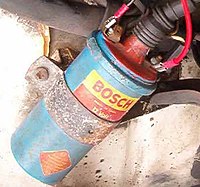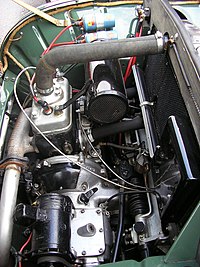Ignition coil



An ignition coil (also called a spark coil) is an induction coil in an automobile's ignition system which transforms the battery's low voltage to the thousands of volts needed to create an electric spark in the spark plugs to ignite the fuel. Some coils have an internal resistor while others rely on a resistor wire or an external resistor to limit the current flowing into the coil from the car's 12-volt supply. The wire that goes from the ignition coil to the distributor and the high voltage wires that go from the distributor to each of the spark plugs are called spark plug wires or high tension leads.
Originally, every ignition coil system required mechanical contact breaker points, and a capacitor (condenser). More recent electronic ignition systems use a power transistor to provide pulses to the ignition coil. A modern passenger automobile may use one ignition coil for each engine cylinder (or pair of cylinders), eliminating fault-prone spark plug cables and a distributor to route the high voltage pulses.
Ignition systems are not required for diesel engines which rely on compression to ignite the fuel/air mixture.
Basic principles
An ignition coil consists of a laminated iron core surrounded by two coils of copper wire. Unlike a power transformer, an ignition coil has an open magnetic circuit - the iron core does not form a closed loop around the windings. The energy that is stored in the magnetic field of the core is the energy that is transferred to the spark plug.
The primary winding has relatively few turns of heavy wire. The secondary winding consists of thousands of turns of smaller wire, insulated for the high voltage by enamel on the wires and layers of oiled paper insulation. The coil is usually inserted into a metal can or plastic case with insulated terminals for the high voltage and low voltage connections. When the contact breaker closes, it allows a current from the battery to build up in the primary winding of the ignition coil. The current does not flow instantly because of the inductance of the coil. Current flowing in the coil produces a magnetic field in the core and in the air surrounding the core. The current must flow long enough to store enough energy in the field for the spark. Once the current has built up to its full level, the contact breaker opens. Since it has a capacitor connected across it, the primary winding and the capacitor form a tuned circuit, and as the stored energy oscillates between the inductor formed by the coil and the capacitor, the changing magnetic field in the core of the coil induces a much larger voltage in the secondary of the coil. More modern electronic ignition systems operate on exactly the same principle, but some rely on charging the capacitor to around 400 volts rather than charging the inductance of the coil. The timing of the opening of the contacts (or switching of the transistor) must be matched to the position of the piston in the cylinder. The spark must occur after the air/fuel mixture is compressed. The contacts are driven off a shaft that is driven by the engine crankshaft, or, if electronic ignition is used, a sensor on the engine shaft controls the timing of the pulses.
The amount of energy in the spark required to ignite the air-fuel mixture varies depending on the pressure and composition of the mixture, and on the speed of the engine. Under laboratory conditions as little as 1 millijoule is required in each spark, but practical coils must deliver much more energy than this to allow for higher pressure, rich or lean mixtures, losses in ignition wiring, and plug fouling and leakage. When gas velocity is high in the spark gap, the arc between the terminals is blown away from the terminals, making the arc longer and requiring more energy in each spark. Between 30 and 70 millijoules are delivered in each spark.
Construction
Formerly, ignition coils were made with varnish and paper insulated high-voltage windings, inserted into a drawn-steel can and filled with oil or asphalt for insulation and moisture protection. Coils on modern automobiles are cast in filled epoxy resins which penetrate any voids within the winding.
A single-spark system has one coil per spark plug. To prevent premature sparking at the start of the primary pulse, a diode or secondary spark gap is installed in the coil to block the reverse pulse that would otherwise form.
In a coil meant for a dual-spark system, the secondary winding has two terminals isolated from the primary, and each terminal connects to a spark plug. With this system, no extra diode is needed since there would be no fuel/air mixture present at the inactive spark plug. [1]
In a low-inductance coil, fewer primary turns are used, so primary current is higher. This is not compatible with the capacity of mechanical breaker points, so solid-state switching is used.
Use in cars
Early gasoline (petrol) internal combustion engines used a magneto ignition system, since no battery was fitted to the vehicle; magnetos are still used in piston-engine aircraft. The voltage produced by a magneto is dependent on the speed of the engine, making starting difficult. A battery-operated coil can provide a high-voltage spark even at low speeds, making starting easier. [2] When batteries became common in automobiles for cranking and lighting, the ignition coil system displaced magneto ignition.
In older vehicles, a single coil would serve all the spark plugs via the ignition distributor. Notable exceptions are the Saab 92, some Volkswagens, and the Wartburg 353 which have one ignition coil per cylinder. The flat twin cylinder 1948 Citroën 2CV used one double ended coil without a distributor, and just contact breakers, in a wasted spark system.
Hitachi Automotive Systems, a Japanese company is a top manufacturer of world class ignition coils used in automotives.
Modern ignition systems
In modern systems, the distributor is omitted and ignition is instead electronically controlled. Much smaller coils are used with one coil for each spark plug or one coil serving two spark plugs (for example two coils in a four-cylinder engine, or three coils in a six-cylinder engine). A large ignition coil puts out about 40 kV, and a small one such as from a lawn mower puts out about 15 kV. These coils may be remotely mounted or they may be placed on top of the spark plug (coil-on-plug or Direct Ignition). Where one coil serves two spark plugs (in two cylinders), it is through the "wasted spark" system. In this arrangement, the coil generates two sparks per cycle to both cylinders. The fuel in the cylinder that is nearing the end of its compression stroke is ignited, whereas the spark in its companion that is nearing the end of its exhaust stroke has no effect. The wasted spark system is more reliable than a single coil system with a distributor and less expensive than coil-on-plug.
Where coils are individually applied per cylinder, they may all be contained in a single molded block with multiple high-tension terminals. This is commonly called a coil-pack.
A bad coil pack may cause a misfire, bad fuel consumption or loss of power.
Related coils
- An Oudin coil is a disruptive discharge coil.
- Low tension coil
See also
- Flyback converter
- Flyback transformer
- Electromagnetism
- Faraday's law of induction
- Induction coil
- Ignition system
- Magnetic field
- Transformer
Patents
- U.S. patent 609,250, "Electrical Igniter for Gas Engines", Nikola Tesla, 1898.
- U.S. patent 1,391,256 - Induction coil structure - Arthur Atwater Kent - 1921
- U.S. patent 1,474,152 - Induction coil - Arthur Atwater Kent - 1923
- U.S. patent 1,474,597 - Induction coil - Arthur Atwater Kent - 1923
- U.S. patent 1,569,756 - Ignition coil - Arthur Atwater Kent - 1926
- U.S. patent 1,723,908 - Ignition system - Ernst Alexanderson - 1929
References
External links
- Interactive tutorial on Ignition Coils at the National High Magnetic Field Laboratory.
